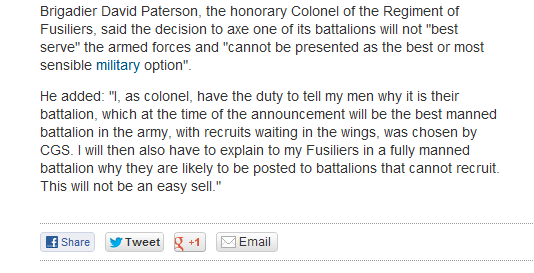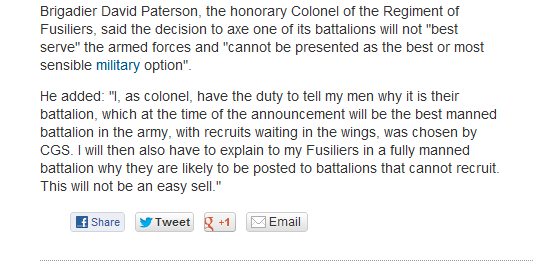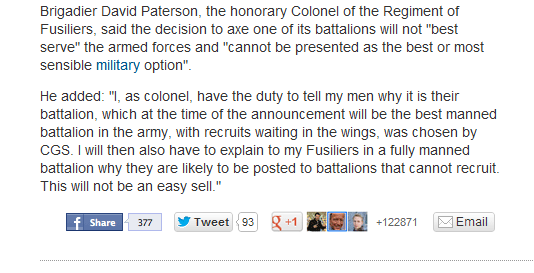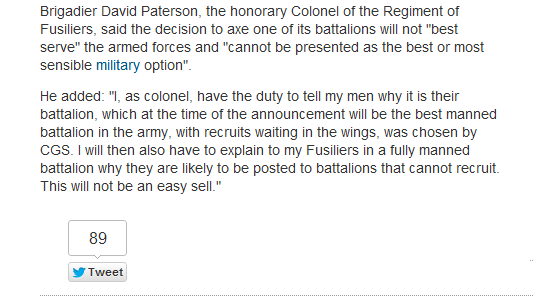How to Improve the Chance Readers Will Click Your ‘Like’, ‘Tweet’ & ‘Share’ Buttons
This blog post offers 5 simple steps to improve the likelihood that readers will tweet, share, like, or ‘plussify’ (is there a word for google+?) your content.
As ever, this will not work if your content has no natural value (or no perceived value) in the first place. This article assumes that you are putting some genuine effort into content.
There is an image accompanying each step: Look closely to spot the simple tweaks.
The Example
Below is an image taken from the foot of an article from The Guardian.

Looking just at the area at the bottom of the image, you’ll recognise a really common way of displaying ‘share links’. This is basically the ‘checkbox’ implementation that you would apply if someone asked you “could you add some share links to our articles?”
Below, we’ll make a few tweaks to this to increase the likelihood of shares.
Step 1: Remove the Ringfence
In the image above, you’ll notice that the ‘share’ buttons have been grouped together & ringfenced into a little block in the page. This looks neat aesthetically, and the reason that it looks neat aesthetically is that they are essentially rinfenced into a block that is easy for your brain to understand “that’s the share button area”.
By ringfencing it like that, and easily identifying it as the ‘share button area’, that automatically tells people who habitually use these links “your sharing stuff is here. click us!” But, of course, it has the negative side effect of saying to everybody else (who does not habitually click sharing buttons) “feel free to ignore us – this entire block is just the sharing stuff you always ignore!”.
Here’s the same area with that ringfencing removed, and the share buttons placed directly into the ‘content’ area:

Not such a big difference, but the equivalent of placing them as ‘the next logical thing to look at’, rather than a dead end stop.
Step 2: Add ‘Social Proof’
‘Social Proof’ is a bit of a cliche, but – speaking incredibly generally – if you show someone that others have taken an action before, they are more likely to take it themselves.
There are many ways to do that, the most simple being to automatically include the number of tweets/likes/shares.

Step 3: Remove the ‘Choice Paralysis’ or ‘Choice Blindness’.
Again speaking very generally, if you offer someone a choice of 5 things, it is far harder for them to decide than if you offer just 1 or 2.
If it is more important to your business to get ‘tweets’ than it is to get ‘shares’, prompt for the ones you want.

Above we’ve included just 1. It’s often better to make big changes first & then taper down, than to go the other way round.
Step 4: Add a Prompt
Many people are not in the ‘habit’ of sharing content directly from web pages. It is not always appropriate, but a simple, friendly prompt can sometimes help to temporarily break that ‘not sharing’ habit on your page:

Step 5: Give it a Go.
Test this and see what actually works for you.
Everything here is a rule of thumb that has worked on some sites and for some audiences, but may not work on others. If you like, it would be very easy to A/B test each of them (for example, it may work better for some audiences if you dramatically highlight your ‘social sharing’ block, rather than simply place it in the content area).
If A/B testing is too much effort, simply take the less scientific approach & try things out for a limited period of time to see if you can judge any change.
That’s it
Please do leave feedback in the comments below. And of course, please do share this article if you think others would find it useful!
Think you’ve hit the nail on the head Dan the less you ask of a reader the more likely an action will be taken.
Great post. You are absolutely correct when it comes to Choice Paralysis, give people too many choices and they are less likely to make a spontaneous decision. Sharebars are the worst things you can put on your site.